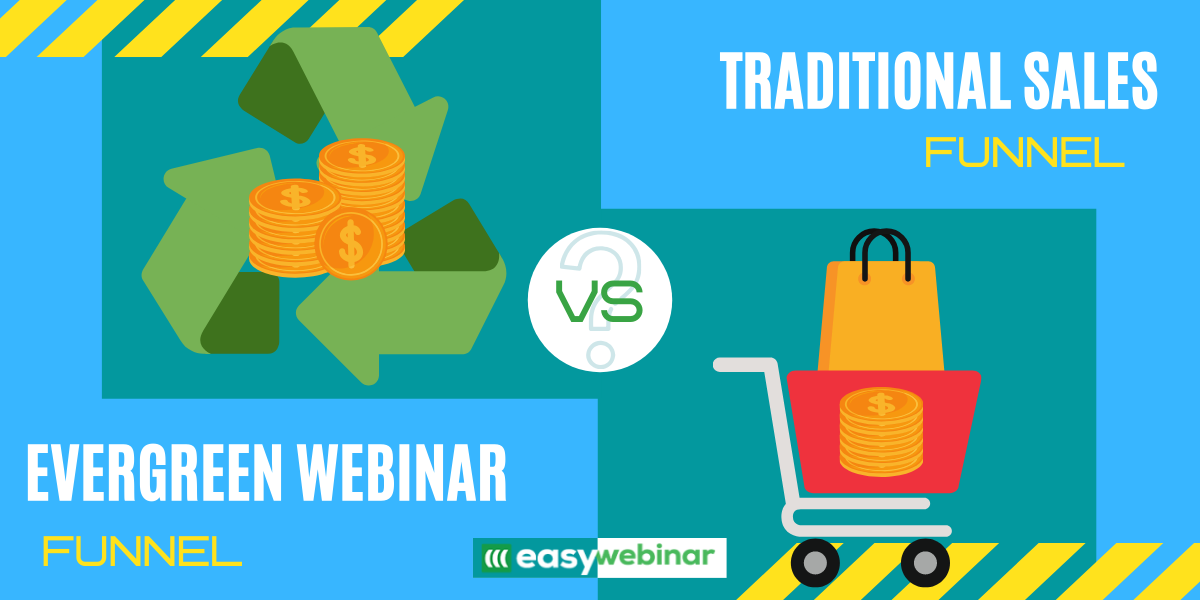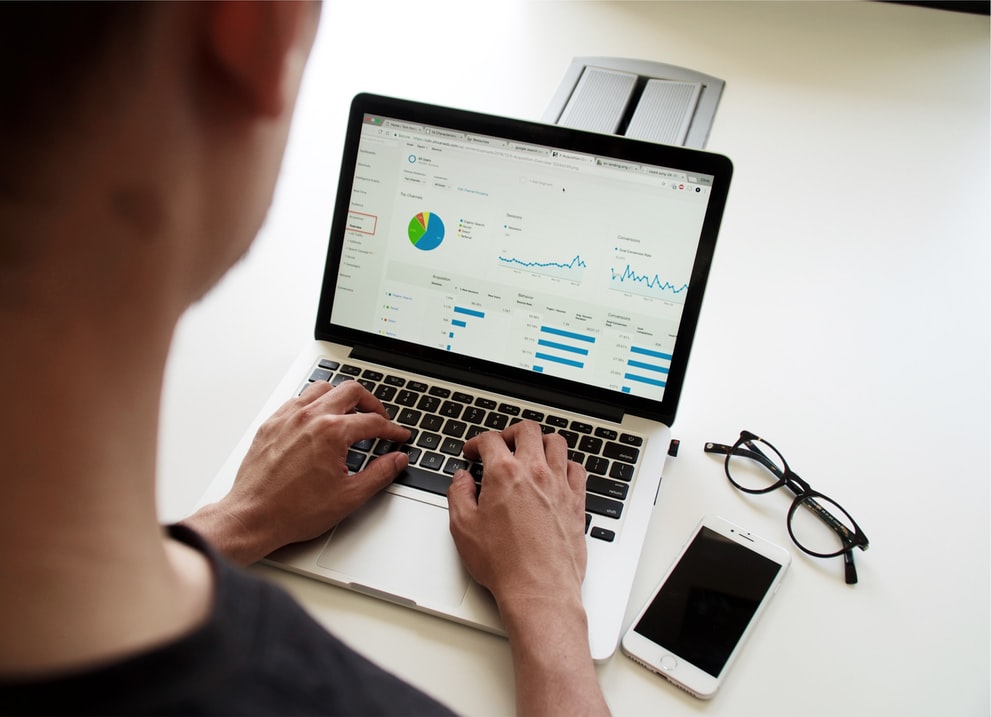Evergreen Webinar Funnel vs. Traditional Sales Funnel

Do you have a sales funnel in your business but aren’t sure if you need an evergreen webinar funnel as well?
If you’re like most internet marketers, you have probably spent a lot of time and money creating a high-converting sales funnel. If you’re an influencer, blogger, or affiliate marketer, sales funnels are a vital piece to your business.
But in this post, I want to share with you how creating a webinar funnel is way more effective than a standard sales funnel.
You might be thinking, what is the difference between a sales and a webinar funnel anyways?
Watch this short video where I break down the difference between the two. Plus, once you see how much revenue you are losing, you will want to start ASAP:
Sales Funnel 101
Here is a quick overview of sales funnels before sharing how they differ from webinar funnels:
What is a Sales Funnel?
So … what exactly is a sales funnel?
As Ryan Deiss said in this Entrepreneur.com article, “The sales funnel as a multi-step, multi-modality process that moves prospective browsers into buyers. It’s multi-stepped because lots must occur between the time that a prospect is aware enough to enter your funnel, to the time when they take action and successfully complete a purchase.”
Basically, a sales funnel gets people from browsing to buying. Sales funnels are how you get people to give you their email in exchange for a gift. In today’s world, you need to give people a reason to do anything.
Whether it’s downloading a free e-book or having them buy a product, you need to guide them through the entire process. A sales funnel does just that.
Traditional Sales Funnel

To better illustrate a sales funnel, let’s assume that a marketer is trying to sell a copywriting digital course. They have a website and they are trying to get people into their funnel so they can provide value and eventually pitch their digital copywriting course.
Here is how a traditional sales funnel would work:
- Opt-in Page / Landing Page – This is the first step in most sales funnels. Users will land on an opt-in page (also known as a squeeze page). Usually, they only have one option, give their name and email or exit the site. For this example, let’s say that once the user gives their name and email, they are then sent a four-day video series about copywriting.
- Four Day Video Series – Once the user gives their email, they get the first email in a sequence. This email will provide a link to watch the first video in a series. In this example, the seller would create a video explaining copywriting and how this one skill has changed their life. Over the next week, the user gets more emails to watch the rest of the copywriting video series. At the end of the seven-day launch, the seller would pitch their online course to start copywriting.
So does this system work?
Yes and no. I know because I once spent $25K on this type of traditional sales funnel to test its effectiveness vs. a webinar sales funnel.
But here’s the thing, I learned that fewer and fewer people watched the videos as the days went on. The first video had the highest watch time, then the second, then the third, and then fourth.
The more time that went on, the fewer people were watching. While I did get results from this sales funnel, they didn’t compare to a webinar funnel.
Use a Webinar Funnel to Increase Your Sales

As I mentioned in the video, during the time I was running this traditional sales funnel, I was also doing a webinar funnel. Here is how a traditional webinar funnel works:
Webinar Registration Page
Similar to a landing page in the traditional sales funnel, a webinar registration page is how people sign up for your event. A webinar registration page usually has 2-3 fields, testimonials, and an overview of what people will learn.
Once someone registers, they are sent an email with the webinar link, date, and time. Plus, you can also send a pre-webinar sequence and share related content. This can help build the know-like-trust factor and establish yourself as an expert before they sign on to the webinar.
Thank You Page

Once someone registers to the webinar, they are taken to a thank you page. The thank-you page normally has event details, social media links, and maybe a video to hype up the webinar.
A sales funnel can also have this after the lead page as well. A lot of internet marketers might even do a one-time offer by discounting a product to have users transact.
But the thank you page of a webinar funnel is almost always just a confirmation of the event and what to do next.
Event Page
The event page is where the webinar actually takes place. For people who registered, they get all the sign-in details to their email.
Once they attend the webinar, they will also get an email followup as well. But unlike a traditional sales webinar, you have a lot more options.
For example, you can send out different emails based on if people attended, left early or didn’t buy. This will allow your marketing to be on point and specific to the user. But if you’re doing a sales funnel and a 4-day video sequence, your options are much more limited.
Timed Replay of Live Webinar

Another benefit of using a webinar funnel is that you can send out timed replays as well. With Easy Webinar’s software, you can tell who attended and who didn’t. For those who weren’t able to make the webinar, you can send them a timed replay.
A timed replay is great because it creates urgency. Usually, you want your timed replay to only be live for 72 hours. A short deadline will force users to watch quickly and hopefully take action.
Webinar Funnel vs. Sales Funnel: What’s the Difference?

As you can tell, there are some huge differences between a traditional sales funnel and a webinar funnel. But the biggest difference that I’ve found is the level of engagement. The webinar funnels have so much higher engagement than someone who can watch a video series on their own time.
I think this happens because webinars allow you to engage with your audience, unlike any other medium. With webinars, you can chat with your attendees and answer questions they might have in real-time. This is something you can’t do from a video or email series.
I’ve also found that with webinar funnels, people stay longer but are also more of a high-value customer. Not only do webinar attendees engage longer but they convert better. And who doesn’t want to have higher conversion rates?

Remember, a webinar funnel is still a sales funnel but it includes a webinar that creates a more immersive experience for users. Unlike a video series, people can chat with others, engage with you, and interactively learn new content.
Plus, webinar users feel the commitment much more than they do a video series. By having a formal event or a timed replay, they need to show up live or watch at a certain time. People that do this are much more qualified and almost always worth more money in the long run.
I’m not just saying that either, this was an actual study done by Segmetrics with EOfire creator John Lee Dumas. In the Segmetrics study, they found that “Leads who registered for an automated webinar in 2015 have been worth $81.05 each — 243% more than leads who didn’t.”
How crazy are these numbers?
The webinar sales funnel were 243% more effective!
While of course, I’m a huge fan of webinars, the numbers show they are more effective than a traditional sales funnel. Webinar funnels create a much more immersive experience that encourages people to take action.
Summary of Webinar Funnels

If you’re going to spend your time and money creating a sales funnel, make sure to create a webinar funnel instead. By including the webinar aspect to your funnel, you will engage with your audience as a much higher level which will almost always lead to higher conversion rates. Plus, since so many marketers are using traditional funnels, people aren’t engaging in the email and video series as they did in the past.
The reason these types of funnels are so much more effective is because of a few reasons. First, they are an event so people need to show up. Unlike a video series that people can watch (or not watch), multi-task, or 2X the video speed.
Another reason is that webinars are a much more immersive experience. Since webinar attendees are learning with others and can ask you questions, they are much more likely to stick around. This is why webinar attendees normally stay an entire 57 minutes on live webinars!
Remember, if JLD was getting a 243% better ROI on webinar leads than a traditional funnel, you should do the. Creating this funnel won’t take much more effort on your end and it will convert at a much higher rate.
Create your first webinar sales experience with Easy Webinar today!